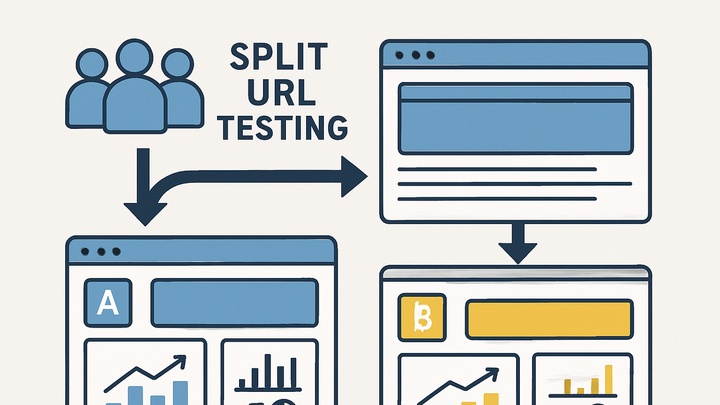Published on 2025-06-27T21:08:30Z
What is Split URL Testing? Examples in GA4 and PlainSignal
Split URL Testing is a web experimentation method that directs visitor segments to entirely different URLs to compare variant performance. Unlike traditional A/B testing, which modifies elements within the same page, split URL tests route traffic to separate page addresses, enabling full control over layout, content, and user flow. This approach is particularly useful when testing radically different designs or landing page structures without complicating on-page code. Analytics platforms like Google Analytics 4 (GA4) and PlainSignal can track these variants by applying filters or query parameters to differentiate traffic. By analyzing metrics such as conversion rate, bounce rate, and session duration across URLs, marketers can determine which page version drives better results. Implementation typically involves setting up URL variants, configuring analytics tracking snippets, and ensuring equal traffic distribution for valid statistical analysis. For example, with PlainSignal’s cookie-free simple analytics snippet, you can quickly instrument each variant and segment by URL in the dashboard.
Split url testing
Split URL Testing directs traffic to different URLs to compare page variants and optimize conversions using analytics metrics.
Overview of Split URL Testing
Split URL Testing is a technique in web analytics where traffic is divided between two or more fully separate URLs to test different page variants. It allows for complete flexibility in design, content, and user experience. This method is distinct from element-level A/B testing and is ideal for scenarios requiring non-trivial structural changes.
-
Definition
Split URL Testing routes segments of traffic to unique page URLs to compare overall performance, rather than tweaking individual elements on the same page.
-
Key differences from a/b testing
Instead of testing variations within a single URL, split URL tests use separate URLs, offering more control but requiring proper setup for each page.
-
Url vs element variation
A/B testing typically changes buttons or images, whereas split URL testing swaps entire pages.
-
Traffic distribution
In split URL tests, traffic is split by redirect or link targeting, not by on-page script.
-
How Split URL Testing Works
The process involves creating distinct URL variants, assigning traffic segments, and then measuring and comparing results across those URLs. It ensures clear attribution of user behavior to each page variant.
-
Setup variants
Develop two or more page versions, each hosted at its own URL (e.g., example.com/variant-a and example.com/variant-b).
-
Traffic allocation
Use redirects, link overrides, or client-side scripting to direct a defined percentage of visitors to each URL.
-
Data collection & analysis
Track visits, engagement, and conversions for each URL in your analytics tool, then compare metrics to identify the top performer.
Implementing Split URL Testing with SaaS Tools
Popular analytics platforms support split URL testing through URL filtering or tagging. Below are examples using GA4 and PlainSignal.
-
Google analytics 4 (GA4)
Although GA4 lacks a native split URL experiment feature, you can implement a test by appending query parameters to your variant URLs and creating custom segments or explorations.\n\n1. Append parameters (e.g., ?variant=A, ?variant=B) to each page URL.\n2. Ensure the GA4 tag is installed on all variants.\n3. In GA4 Explorations, create filters on the page_location dimension for each variant.\n4. Analyze metrics like engagement, conversion rate, and bounce rate across variants.\n\nExample GA4 tracking code:\n
html\n<script async src="https://www.googletagmanager.com/gtag/js?id=G-XXXXXXXXXX"></script>\n<script>\n window.dataLayer = window.dataLayer || [];\n function gtag(){dataLayer.push(arguments);}\n gtag('js', new Date());\n gtag('config', 'G-XXXXXXXXXX');\n</script>\n -
PlainSignal
PlainSignal offers a lightweight, cookie-free analytics solution that you can deploy quickly on each variant URL. Use its dashboard to filter by path or parameters and compare performance.\n\nImplementation example:\n
html\n<link rel="preconnect" href="//eu.plainsignal.com/" crossorigin />\n<script defer data-do="yourwebsitedomain.com" data-id="0GQV1xmtzQQ" data-api="//eu.plainsignal.com" src="//cdn.plainsignal.com/plainsignal-min.js"></script>\n
Best Practices and Considerations
To achieve reliable and actionable insights from split URL tests, follow these best practices and be aware of common pitfalls.
-
Consistent url structure
Keep URLs identical except for the variant identifier to avoid SEO or tracking discrepancies.
-
Equal traffic distribution
Aim for balanced or statistically appropriate traffic splits to ensure fair comparison.
-
Sufficient sample size
Run tests long enough to gather statistically significant data and avoid premature conclusions.
